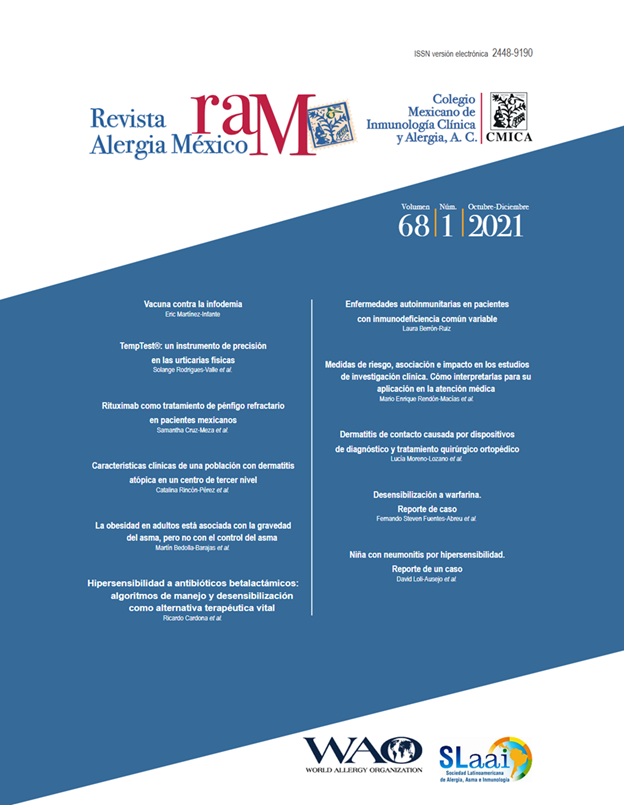Abstract
The practice of evidence-based medicine includes the critical analysis of clinical research studies, and, within it, the interpretation of the results reported. In addition, to statistical data, there are estimators that can help clinicians transfer research findings to routine clinical practice. These estimators are measures of risk, association, and impact. Risk measures report current uncertainty or probability (prevalence of a disease, sensitivity, specificity) or for future events (cumulative incidence, incidence density). Measures of association are related to the identification of the risk in order to determine whether certain factors increase or decrease the probability of development of a disease (relative risk, odds ratio, hazard ratio). While measures of impact allow, among other things, to estimate the effect of a treatment (relative risk reduction, absolute risk reduction, number needed to treat). In this review, each of these estimators is described, defined, and presented with examples.
References
Sackett DL, Strauss SR, Richardson WS, Haynes B. Evidence based medicine: how to practice and teach EBM. Reino Unido: Churchill Livingstone; 2000.
Twells LK. Evidence-based decision-making 1: critical appraisal. Methods Mol Biol. 2015;1281:385-96. DOI: 10.1007/978-1-4939-2428-8_23
Szklo M, Nieto FJ. Epidemiology, beyond the basics. EE. UU.: Aspen Published Editors; 2000.
Citrome L. Relative vs. absolute measures of benefit a risk: what’s the difference? Acta Psychiatrica Scandinavica. 2010;121(2):94-102. DOI: 10.1111/j.1600-0447.2009.01449.x
Chittaranjan A. Understanding relative risk, odds ratio, and related terms: as simple as it can get. J Clin Psychiatry. 2015;76(7):e857-e861. DOI: 10.4088/JCP.15f10150
Rendón-Macías ME, Riojas-Garza A, Contreras-Estrada D, Martínez-Ezquerro JD. Bayesian analysis. Basic and practical concepts for its interpretation and use. Rev Alerg Mex. 2018;65(3):285-298. DOI: 10.29262/ram.v65i3.512
Santos AF, Douir A, Bécares N, Wu S-Y, Stephens A, Chan SM, et al. Basophil activation test discriminates between allergy and tolerance in peanut-sensitized children. J Allergy Clin Immunol 2014;134(3):645-652. DOI: 10.1016/j.jaci.2014.04.039
Lo P-C, Lin S-H, Lai J-N. Long-term use of Chinese herbal medicine therapy reduced the risk of asthma hospitalization in school-age children: A nationwide population-based cohort study in Taiwan. J Trad Complement Med. 2020;10(2):141-149. DOI: 10.1016/j.jtcme.2019.04.005
Bahoush G, Poorasgari A, Nomoji M. Relationship of primary immune thrombocytopenic purpura and atopic among children: a case control study. Sci Rep. 2020;10(1):11717. Disponible en: https://www.nature.com/articles/s41598-020-68647-2
Daya S. Measures used to summarize the effects of therapy. Evidence-Based Obstet & Gynecols. 1999;3:3-4.
Akobeng AK. Understanding measures of treatment effect in clinical trials. Arch Dis Child. 2005;90:54-56. Disponible en: https://adc.bmj.com/content/90/1/54
Citrome L, Ketter TA. When does a difference make a difference? Interpretation of number needed to treat, number needed to harm, and likelihood to be helped or harmed. Int J Clin Pract. 2013;67(5):407-411. DOI: 10.1111/ijcp.12142
Nahm DH, Ye TM, Shin YS, Park HS, Kim ME, Kwon B, et al. Efficacy, safety, and immunomodulatory effect of the intramuscular administration of autologous total immunoglobulin G of atopic dermatitis: a randomized clinical trial. Allergy Asthma Immunol Res. 2020;12(6):949-963. DOI: 10.4168/aair.2020.12.6.949
Sampson HA, Shreeffler WG, Yang WH, Sussman GL, Nadeau KC, Cheema AS, et al. Effect of varying doses of epicutaneous inmmunotherapy vs placebo on reaction to peanut protein exposure among patients with peanut sensitivity: a randomized clinical trial. JAMA. 2017;318(18):1798-1809. DOI: 10.1001/jama.2017.16591
Simundic AM. Bias in research. Biochem Med (Zagreb). 2013;23(1):12-15. DOI: 10.11613/BM.2013.003
Tripepi G, Jager KJ, Dekker FW, Zoccali C. Selection bias and information bias in clinical research. Nephron Clin Pract. 2010;115:c94-99. DOI: 10.1159/000312871
Martínez-Esquerro JD, Riojas-Garza A, Rendón-Macías ME. Clinical significance vs statistical significance. How to interpret the confidence interval at 95. Rev Alerg Mex. 2017;64(4):477-486. DOI: 10.29262/ram.v64i4.334

This work is licensed under a Creative Commons Attribution-NonCommercial 4.0 International License.
Copyright (c) 2021 Revista Alergia México

